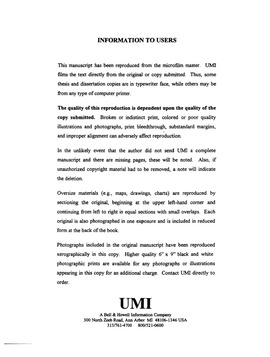| dc.contributor.advisor | Nollert, Matthias Ulli, | en_US |
| dc.contributor.author | Forlow, Stephen Bradley. | en_US |
| dc.date.accessioned | 2013-08-16T12:30:09Z | |
| dc.date.available | 2013-08-16T12:30:09Z | |
| dc.date.issued | 1998 | en_US |
| dc.identifier.uri | https://hdl.handle.net/11244/5682 | |
| dc.description.abstract | The recruitment of circulating leukocytes to areas of infection and injury is an important aspect of the immune response process. Leukocytes initially attach to and roll on the activated endothelial cells lining the blood vessel wall. It has recently been shown in vitro that leukocyte-leukocyte interactions mediated by L-selectin and PSGL-1 enhance accumulation of cells. We have recreated these initial cell recruitment events in vitro using simplified systems. We have identified a novel mechanism that enables cell-cell interactions to occur which may contribute in the recruitment of cells. P-selectin-expressing platelet microparticles can act as a bridge between PSGL-1-expressing cells allowing them to interact. Platelet microparticle concentrations are elevated in many diseases and disorders; however, little work has been done to show if platelet microparticles play any role in clotting, cell aggregation, or cell accumulation. HL-60 cells or neutrophils in the presence of platelet microparticles were withdrawn over HL-60 cells prebound to a glass slide. We have shown that platelet microparticles can mediate cell aggregation, cell-cell interactions, and enhanced cell recruitment through cell-cell interactions. Increasing the concentration of platelet microparticles in the system resulted in an increase in the number of cell-cell interactions, an increase in the number and size of cell aggregates, an increase in the number of cell-cell interactions at higher shear stresses, and an increase in cell accumulation on the surface. We also analyzed the kinetic off-rate of the selectin adhesion molecules. We have measured the off-rate of P-, E-, and L-selectin in various systems including using lipid bilayers and CHO cells as the surface and using neutrophils, HL-60 cells, and pre-B cells as the circulating cell. The off-rates for P- and E-selectin were approximately the same; however, the off-rate for L-selectin was found to be much faster. The calculated off-rates were not dependent on how either the selectin or PSGL-1 was presented. This shows the off-rate is strongly dependent on the interactions between the molecules, but not strongly dependent on how the molecules are displayed on the surface. This also suggests that the kinetics are a result of the dissociation of the receptor-ligand bond and not the extraction of the receptor from the membrane. | en_US |
| dc.format.extent | xiii, 209 leaves : | en_US |
| dc.subject | Chemistry, Biochemistry. | en_US |
| dc.subject | Cell adhesion molecules. | en_US |
| dc.subject | Health Sciences, Immunology. | en_US |
| dc.subject | Leucocytes. | en_US |
| dc.subject | Blood platelets Aggregation. | en_US |
| dc.subject | Biology, Cell. | en_US |
| dc.title | Characterization of the biochemical and biophysical mechanisms fundamental to receptor-mediated white blood cell accumulation. | en_US |
| dc.type | Thesis | en_US |
| dc.thesis.degree | Ph.D. | en_US |
| dc.thesis.degreeDiscipline | School of Chemical, Biological and Materials Engineering | en_US |
| dc.note | Source: Dissertation Abstracts International, Volume: 59-07, Section: B, page: 3177. | en_US |
| dc.note | Adviser: Matthias Ulli Nollert. | en_US |
| ou.identifier | (UMI)AAI9839816 | en_US |
| ou.group | College of Engineering::School of Chemical, Biological and Materials Engineering | |
